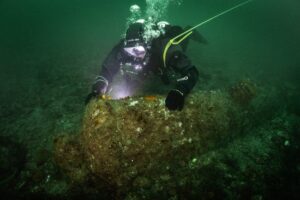When departing from Hurghada, heading towards Sinai, one must pass by the Sha’ab Abu Nuhas reef. Until the construction of the Suez Canal, and immediately after its opening, this coral reef was located along the route of ships sailing the Red Sea. At that time, unmarked and unregistered in nautical charts, it was the cause of many shipwrecks. Consequently, Sha’ab Abu Nuhas is one of the most popular places for wreck diving nowadays.
As many as four sunken ships are available to recreational divers: Gianis D, Kimon M, Marcus (Crisoula K) and Carnatic. All of these shipwrecks are shrouded in mystery and suspicious circumstances, but the SS Carnatic is especially interesting for its story and because of the cargo it was carrying which consisted of wine, copper, and of course, gold.
Historical data
The SS Carnatic was a combination of a steamship and sailing ship. Apart from the fact that its construction had a combined purpose, it was also a mix of a passenger and a cargo ship. The Samuda brothers made it for the maritime operator ‘Peninsular and Oriental Steam Navigation Company’. On September 12th, 1869, Carnatic sailed from Suez to its final destination, the port of Bombay in India. During the night, due to a navigation error, it approached Shadwan Island, getting too close and becoming stranded on Sha’ab Abu Nuhas ridge. Although the water penetrated the ship very quickly, the crew tried to save it. The struggle lasted for 34 hours, and at one point Carnatic began sinking quickly, pulling 24 crew members and 5 passengers below the surface with it. Gold coins, copper plates and quality wine also disappeared under the surface of the Red Sea. The surviving sailors sailed to a nearby island where they were found by the ship ‘Sumatra’ which was sent to their rescue.
Extracting the ship’s cargo started a couple of weeks after its sinking. The value of the cargo was significant, so it was done urgently. According to historical data, all gold coins were removed, as well as the Royal Post and copper plates. The fate of the wine still remains unknown.
Diving on the Carnatic
This site is usually visited by liveboards on the northern route. Large boats are moored on the sheltered side of the reef, while the location is reached by dinghy. Carnatic is 90 meters long and lies along the reef at a maximum depth of 26 meters. The wreck has collapsed in the middle of the hull, but the stern and bow are clearly visible. The wooden parts of the deck have completely rotted away, but the construction is still in a solid condition. After 152 years under the sea, the Carnatic fits in great with the reef, as it is largely overgrown with soft corals that give it a special look.
As the historical data says the entire cargo was removed, however, local divers like to leave fake gold coins (chocolates) on the wreck and thus raise the adrenaline for inexperienced tourist divers.
Considering the turbulent history of this ship, its specific shape as well as the very rich marine wildlife that inhabits it, Carnatic is a wreck that should not be missed!
Written by Janez Kranjc
Photos by Dejan Suba Subotic and Nikola Doder
More about diving at this dive site: www.okdivingsafari.com
The post The mystery of the sunken treasure of the SS Carnatic appeared first on Mares – Scuba Diving Blog.
Read MoreDiving, Carnatic, Egypt, gold, red sea, Sha’ab Abu Nuhas, treasure, wreck, wreck divingMares – Scuba Diving Blog

